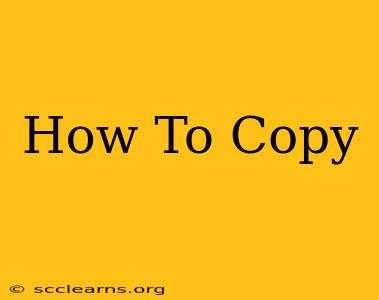Copying, in the context of marketing and writing, isn't about plagiarism. It's about skillfully replicating the essence of a message, a style, or a technique to achieve a specific goal. Whether you're crafting compelling ad copy, writing engaging social media posts, or adapting content for different platforms, mastering the art of copying is crucial for success. This guide will equip you with the strategies and techniques to become a copywriting master.
Understanding the Core Principles of Effective Copying
Before diving into specific techniques, it's essential to grasp the underlying principles of effective copying:
- Know Your Audience: Who are you trying to reach? Understanding your target audience's needs, desires, and pain points is paramount. Your copy must resonate with them on a personal level.
- Define Your Goal: What do you want your copy to achieve? Increased website traffic? More sales? Brand awareness? A clear objective will guide your writing and ensure your copy is focused and effective.
- Craft a Compelling Message: Your copy needs to be clear, concise, and persuasive. It should grab the reader's attention and communicate your message effectively.
- Choose the Right Tone and Style: The tone and style of your copy should align with your brand and target audience. A formal tone might be appropriate for a financial institution, while a playful tone might be better suited for a clothing brand.
- Call to Action (CTA): Every piece of copy needs a clear call to action. Tell your audience what you want them to do – visit your website, make a purchase, sign up for a newsletter, etc.
Types of Copying and Their Applications
Effective copying takes many forms. Here are a few key types:
1. Direct Copy: Replicating Successful Campaigns
Analyzing successful marketing campaigns and adapting their strategies for your own use can be a powerful technique. However, always ensure you're not directly plagiarizing; adapt and improve upon the existing work. Focus on the underlying messaging and structure, modifying it to fit your unique brand and audience.
2. Adaptive Copy: Modifying Content for Different Platforms
The same message can be presented differently across various platforms. A Facebook ad might use short, punchy sentences, while a blog post might adopt a more conversational and detailed style. Adaptive copy ensures your message remains consistent yet resonates with each audience uniquely.
3. Creative Copy: Developing Unique and Engaging Content
This involves generating entirely original content. This often requires brainstorming, research, and a deep understanding of your target audience. Creativity is key!
Techniques for Effective Copying
Here are practical techniques to improve your copywriting skills:
- Use Strong Verbs: Replace weak verbs with stronger, more evocative alternatives.
- Employ Power Words: Incorporate words with emotional impact to resonate with your audience.
- Tell Stories: People connect with stories. Use storytelling to make your copy more engaging and memorable.
- Use Data and Statistics: Back up your claims with credible data to build trust and credibility.
- A/B Testing: Experiment with different versions of your copy to see which performs best.
Mastering the Art of Copying: A Continuous Process
Becoming a master copywriter takes time and practice. Continuously analyze successful campaigns, experiment with different techniques, and learn from your mistakes. By understanding your audience, defining your goals, and employing effective techniques, you can create compelling copy that achieves remarkable results. Remember, ethical copying is about learning and adapting—not stealing.

